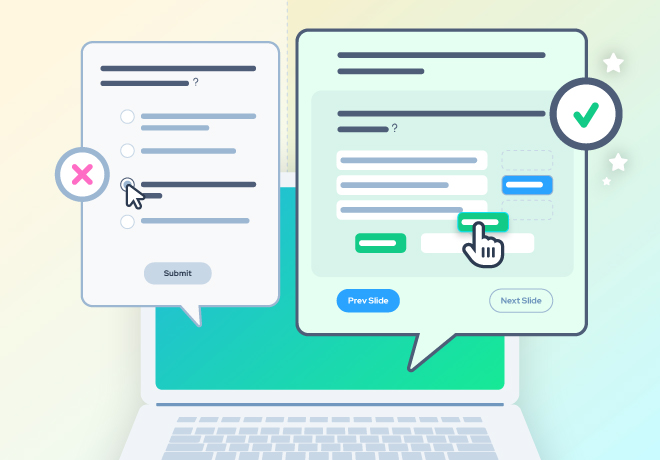
What is a training audit?

Related articles
Get valuable eLearning insights to your inbox.
Listen to Neovation’s Demystifying eLearning podcast generated with NotebookLM!
Listen to our podcast on your favorite platform!
If your organization is like the one I work for, at some point, you will experience some form of an audit.
AUDIT! That word strikes fear in the heart of almost every person. It brings up a wide range of emotions – a sense of vulnerability, a fear of being caught without your ducks in a row. Think of it this way. A training audit is a hard-headed, fact-based assessment of whether the work you and your Learning and Development (L&D) team have been doing has been valuable or a waste of resources, with no quarter given for circumstances beyond your control.
Take a breath. I want to change your thinking on the importance and power of a training audit. Instead of viewing it as a “Spanish Inquisition” (and no one expects the Spanish Inquisition!) I invite you to see a training audit as an opportunity to prove the value of the work you and your L&D team have been doing and a chance to quantify the results. We can’t improve what we don’t measure – so view this process as something that will illuminate your accomplishments and the opportunities where you can up your game.
To help make you feel a little more at ease with the idea of a training audit, here’s what we’re going to cover in this article:
- Why a training audit is important for your organization,
- The five key components to completing a successful training audit,
- When you might want to consider hiring an external learning consultant to run your training audit, and what to look for in a potential candidate, and
- The next steps to take after you’ve completed your train#ing audit.
Feeling better? I hope so. Maybe we should start calling this process a Training Review – that might take a while to catch on industry-wide, so for now, “audit” is the term we’ll use.
Simply said, a training audit is a full top-to-bottom assessment of your existing training materials. It is a big job, and the health of your training program depends on the thoroughness of the audit and the resulting strategy. It is not something that should be rushed through or done in a casual or haphazard fashion – it is a vital part of your online training strategy.
Does your training content need a refresh? Get a free quote to see how Neovation can rejuvenate your current employee training materials.
Why a training audit is important
They say, “nothing is as constant as change.” This quote is especially true as today’s companies strive to earn and maintain their market share, ensure profitability for their stakeholders, and retain employees. In times of financial uncertainty, training/L&D budgets are often among the first cost-cutting casualties (along with marketing.)

Are you challenged by the continuous change within your organization and want to ensure that every aspect of your organizational intelligence keeps up? Do you want to prove your program is making a positive fiscal impact or fix what needs repair to improve your return on investment (ROI)? A thorough training audit is the best way to adapt successfully to your company’s changing needs – especially since employee training and retention have such a strong impact on your company’s performance and productivity goals.
A training audit:
- Is objective. It delivers objective benchmarks and insights into your training program. These benchmarks can be internal or external if you can obtain reliable data on training Key Performance Indicators (KPIs) for your specific industry.
- Is insightful. It allows you to evaluate the performance of your learners in various cohorts
- Is strategic. It guides you by providing recommendations for future training strategies
- Is fiscally relevant. It demonstrates the ROI of your program with empirical numbers for engagement, retention, and KPI improvement.
- Is illuminating. It highlights the value that training, and your team of training creators, deliver as value creators within your company, shining a light on unnoticed ongoing productivity and performance achievements.
You want to ensure that your training audit is deep and broad. You need to check your assumptions, hopes, dreams, and emotional attachment to your training program and be prepared for a factual assessment of your work and the results, as seen through learner performance, engagement, and KPI movement. Embrace the journey of objective discovery that a training audit provides. Then, develop and execute your newly-developed strategic plan to improve your empirical results before (gasp) the next audit.
Let’s dig into what that looks like at a high level.
The five key components of a training audit

Start with the end in mind
While the training audit aims to analyze your current training content, identify gaps, and suggest improvements, you need to think about what you want your training to achieve. What are your KPIs that prove the ROI of your training investment? Here’s a partial list – all based on job function and the cohort of trainees.
KPI: Production metrics
- Health and Safety Statistics – fewer accidents on the job, which injure employees and slow production, compliance recertification
KPI: Retention metrics
- Service Delivery – consistency in client-facing service provision - onboarding, implementation, reduced ticket times, improved client care metrics
- Strengthened Customer Lifecycle – improving customer satisfaction, reducing churn, earning repeat and referral business
- Product knowledge – features, functionality, inventory, provision of replacement parts, troubleshooting, updates, upgrades
KPI: Business development metrics
- Improved Sales performance – improving lead quality and volume, shortening the sales cycle, overcoming objections
KPI: Human capital metrics
- Soft skills, hard skills, and managerial training - upskilling, reskilling, career development, certifications
- Administrative Supports – often delivered through a knowledge base, training in the form of performance supports and job aids, the “how to” of your company’s HR department – filing health claims, expense reports, time off requests, etc.
There are likely items on your list, ones that are more that are specific to your business. Understanding the impact of improved training content and delivering on these KPIs will help you be strategic as you dive deeply into your training process and materials.
Catalog your training program assets
You will need to put together a comprehensive list of all the training content you have developed and a list of all the training programs your learners can access within your online training delivery platform. This catalog will help you refine each training program to ensure the content is complete and current and achieves the desired learning goals.
Dig into your data and learner feedback to measure course effectiveness

Look at your data to see which programs have had the most enrollments and how well learners have performed in those courses. Poor performance metrics may indicate that a program requires review and updating. What courses have high and low engagement? If some courses are learner-selected, what are the most popular, and why? Compare various programs' performance, looking at how training is delivered – do courses with more interactive or multi-media elements have higher or lower learner engagement and results? This learner data will give you insight into which programs or courses are more effective. You can also use polls or surveys to obtain direct learner feedback.
Evaluate employee performance
Have your targeted KPIs improved? Compare employee performance data, like workplace accidents, absenteeism, promotability, skill-based improvement, productivity, increased sales, customer satisfaction data, etc., from before training was implemented to current metrics. Effective training improves performance. If there is an insufficient improvement on your KPIs, then your training material may not be effective, your delivery platform may not be engaging, or your assessment and measurement metrics may need re-evaluation.
Determine where you can improve
This is where you identify the areas where you may need to implement new technologies, new strategies, or both to make your training program better serve you as the Training Manager, your company KPIs and your learners. As you assess and determine the correlation and causation between your training content and your desired result, you will discover opportunities for improvement. You will be working with four different types of data that answer these questions:
- Is your course content correct, current, and delivered in the best format to engage your learners and build retention?
- What patterns do you see when you compare learner performance for each course or learning plan – has the data revealed specific issues (like all learners fail question 3?)
- What learner feedback have you received about specific courses or your training initiatives as a whole?
- What KPIs are being influenced through your training program – are the metrics moving in the right direction? What results do you want to see?
This sounds complicated. Should I hire an external consultant?
If you have been delivering in-person training (instructor-led training or ILT) or video training (webinars) or have been using a learning management system to deliver training to your team and want to maximize the results of your training audit, I recommend hiring a training or learning consultant.
There’s no way around it. We all get too close to the work we do every day. We come to work armed with prior knowledge and assumptions – and we forget how much information is inherently “in our DNA” and not obvious to everyone.
We overlook the weak spots or miss the gaps because we’ve always just worked around things. And if you’re reading this thinking, that doesn’t mean me – then I’m here to tell you that it absolutely does mean you. Yes, YOU.
What to look for in a consultant
Sometimes, it’s great to have a pair (or two) of outside eyes take stock of your resources.
We recommend calling on an external learning consultant to perform a training audit rather than conducting one with in-house personnel – especially if this is your first-ever training audit. This professional should have a proven track record of successful consultations. They may be part of a company that provides some form of eLearning platform or service or a stand-alone consultant. They may have specialized expertise in things like graphic design and instructional design.
The thing to watch for is that they provide you with a fair, balanced, and AGNOSTIC report – not recommending themselves as the only solution to your current project.
A professional consultant will examine your needs and existing training, bringing that valuable, insightful, outside perspective that captures a big-picture view of your organization’s needs. They will ask the tough questions that you or your team may be reluctant to ask each other. By figuring out what is working and what is not and inventorying your content, the online training consultant can create tailored recommendations for your organization.
Some companies that offer learning platform products will include a training audit as part of their sales offering when you purchase their platform. This inclusion can make a training audit more affordable. You’ll want to get as much information as possible about:
- the scope of the audit they offer
- if there is an extra cost (or a tiered cost approach based on the scope of the audit)
- the experience of the team that will be involved in the audit
All the same questions you would ask any consultant, actually – the bonus is this is a value-added service your LMS platform is providing to you.
How to get the most from your consultant
Beware anyone that wants to present a cookie-cutter approach. Make sure they give you good answers to your questions and dig deep into the corners of your human capital development programs. No stone should be left unturned.
Also, challenge their assumptions – you need to ensure they have all the facts and that any differences of opinion or information they may encounter are revealed and resolved. Hold nothing back – even your failures and frustrations. They need to “Know All,” and they are likely not psychic.
A good consultant offers a fair and balanced approach to their work. They may find things you are doing well – pat yourself on the back. They will no doubt encounter things you could have/should have been doing better – that’s okay. A sacred cow or two may be put out to pasture. Wave goodbye with a smile. A consultant will present ideas that challenge the status quo, the operational flow, and more. Everything has to be on the table and open to investigation and consideration. True transparency ensures you will get value for your consulting investment.
What to expect from your eLearning consultant
A professional external training auditor will create a strategic plan that speaks to your company's unique needs while aligning with best practices that make sense – once you understand how those new ways of doing things fit and deliver on the promises of online training. The consultant may recommend purchasing or creating specific training materials but will also consider performance support and knowledge retention needs, including recommendations for nurturing a learning culture and more.
It’s true that in larger organizations, the Chief Learning Officer “could” conduct an audit of the organization’s training program and create a strategic plan. However, a consultant's outside perspective is often helpful, as they have the freedom to explore new solutions due to their lack of history with the organization and have no bias. This impartiality becomes your organization’s opportunity to step away from the “same old same” and reinvent your training and development program from the ground up. Don’t miss this!
To sum it up – your consultant should have deep knowledge and experience in adult learning and online training and be able to provide the big-picture view essential to creating a far-ranging strategy that will serve your organization for years to come. They must deliver a plan that you can act on that is affordable and makes sense for your organization.
Next steps for your training audit
See, that wasn’t so scary! And you may even have the opportunity to bring in a trusted advisor to help you do the heavy lifting. Remember, a training audit should show what has been working, what could be improved upon, and where the gaps are in your training materials. Your goal is to improve your training content, engage your learners better, and move the needle forward on the KPIs that matter. I’ll say it again – you can’t improve what you don’t measure – and to measure things, you first need to evaluate them.
If you're looking for more information about how to build your training program, including various types of training available, review topics on our introduction to online training page.

With 15+ years of online marketing and online learning experience, Susan loves to share insights about where these two ROI-building practices can intersect and complement each other for your business or organization.
Become part of our L&D community
We publish a new learning hub article — full of useful, practical topics — weekly.
Not sure where where you want to start? Jump into one of our recently published articles and see where it takes you!








-svg.svg)
-svg.svg)
-svg.svg)
-svg.svg)